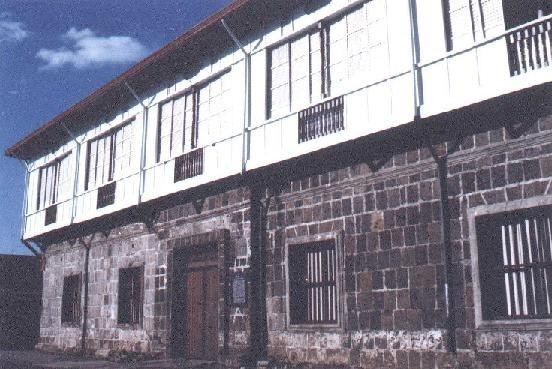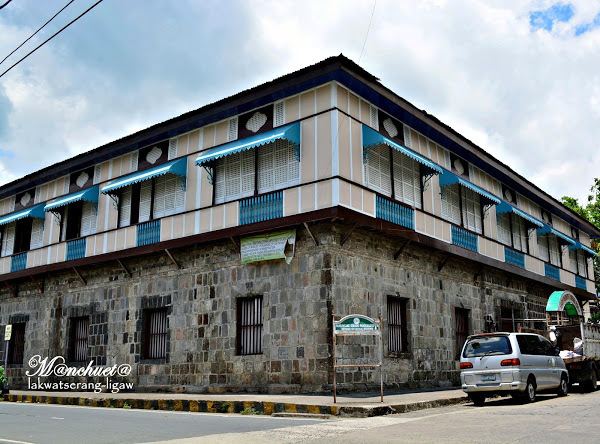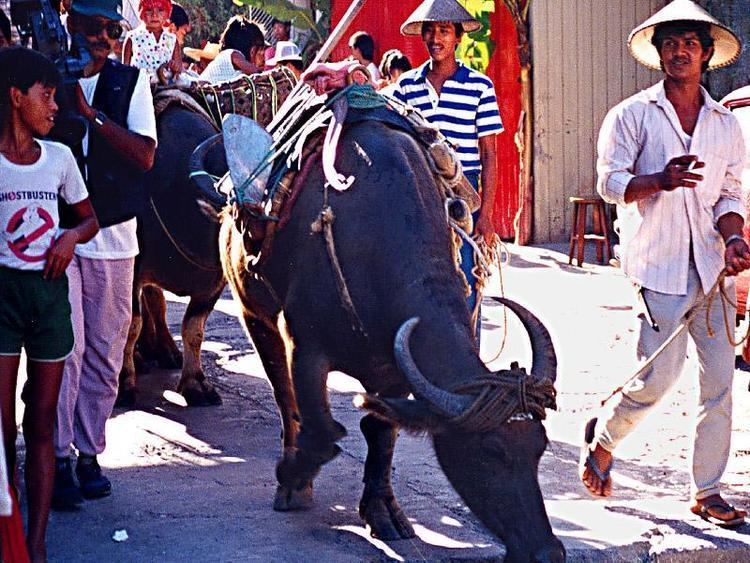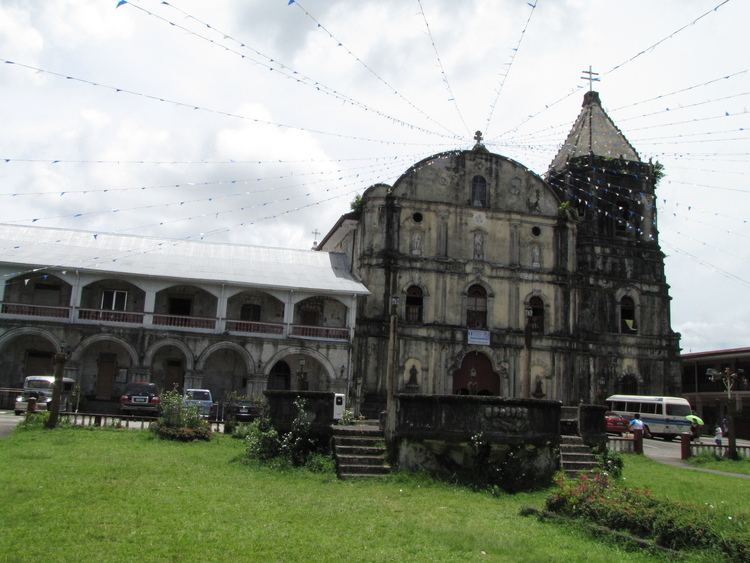Country Region CALABARZON Founded 1578 | Area 230.95 km2 District 1st district of Quezon | |
 | ||
Mayor Faustino Silang (Lakas–CMD) | ||
Map of Tayabas
Tayabas, officially the City of Tayabas (Filipino: Lungsod ng Tayabas), is a city located in Quezon Province, the Philippines. According to the 2015 census, it has a population of 99,779 people. Tayabas is known for lambanog (coconut arrack) and sweet food/delicacies, as well as tourism resorts. Tayabas is also known as the City of Festivals because of its colorful festivals. The city is famous for resorts, heritage houses, historical landmarks, rest and recreation destination and festivities. It is the former capital of the Province of Tayabas, now Aurora and Quezon.
Contents
- Map of Tayabas
- Its more fun in tayabasquezon philippines part 2 of 4
- Its more fun in tayabasquezon philippines part 1 of 4
- Barangays
- History
- Cityhood
- Economy
- The City of Festivals
- Festivals Celebration
- Places of interest
- Nagar House
- Ruins of the San Agustin Mansion
- Sun Yat sen School
- Baldovino House
- Abesamis House
- Sumilang House
- Orias House
- Transportation
- Local government
- Education
- Notable people from Tayabas
- Twin townscities
- References

Its more fun in tayabasquezon philippines part 2 of 4
Its more fun in tayabasquezon philippines part 1 of 4
Barangays

Tayabas is politically subdivided into 66 barangays.
History

In 1578, Fray Juan de Plasencia and Fray Diego de Oropesa, two Franciscan missionaries from Spain founded the town of Tayabas in order to spread Christianity to its natives. Prior to the occupation, however, the native Tayabenses lived in rural settings typical to those times, with barangays headed by village chiefs and councils of elders.

From 1605 to 1901, Tayabas was the capital of the Province of Tayabas, now known as Quezon. In the 19th century, Tayabas was among the biggest towns in the country. Its Minor Basilica of St. Michael the Archangel, which was enlarged in the mid-1850s, is the longest church in the country and is a lasting testament to its glorious and historic past.
In more than three centuries of Spanish occupation, only eight cities and towns were given the title of Villa, and Tayabas was one of them. These are La Villa del Santisimo Nombre de Jesus de Cebu in 1565, La Villa de Santiago de Libon (Albay, 1573), La Villa Fernandina de Vigan (Ilocos, 1574), La Villa Rica de Arevalo (Iloilo, 1581), La Noble Villa de Pila (Laguna, 1610), La Muy Noble Villa de Tayabas, (Tayabas, 1703), La Villa de Bacolor (Pampanga, 1765), La Villa de Lipa (Batangas, 1887). Interestingly, Tayabas was given the title of 'most noble' villa which means it was put in the ranks of nobility.
In the book "The Philippines," written by French traveler Jean Baptiste Mallat, and published in 1846, it appears that Tayabas had more than 21,000 people at that time. This was reduced to 16,000 when Lucena became an independent town in 1879. Due to low population growth during the Spanish period, this number remained unchanged until the coming of the Americans.
Tayabas is at the center of the province's long-settled heartland, which possessed the best lands, the oldest parishes, and the most active commercial centers. The provincial heartland was described by Pres. Manuel L. Quezon as having the "richest and gayest places in the province."
Tayabas has many places of interest. Its Casa Comunidad, a centuries-old building, is the place where Apolinario "Hermano Pule" Dela Cruz was tried and sentenced to death in 1841. It was restored in the 1990s through funds donated by the "Friends of Casa Comunidad," an organization of affluent Manila-based Tayabenses.
Its numerous Spanish-era bridges mirror its rich architectural past. Two of the longest are the Malagonlong and the Malaoa bridges. Malagonlong's high and beautiful arches and its solid design are some of the reasons why it was declared a national historical site. It is so strong that it withstood the dynamites planted there to stop the Japanese advance during World War II.
Tayabas suffered a terrible blow near the end of World War II when it was completely burned to the ground after a bombing raid on March 15, 1945. Prior to that, the old houses of Tayabas rivalled those of Vigan's Spanish-era structures.
Cityhood
During the 11th Congress (1998–2001), Congress enacted into law 33 bills converting 33 municipalities into cities. However, Congress did not act on a further 24 bills converting 24 other municipalities into cities.
During the 12th Congress (2001–2004), Congress enacted into law Republic Act No. 9009 (RA 9009), which took effect on 30 June 2001. RA 9009 amended Section 450 of the Local Government Code by increasing the annual income requirement for conversion of a municipality into a city from ₱20 million to ₱100 million. The rationale for the amendment was to restrain, in the words of Senator Aquilino Pimentel, "the mad rush" of municipalities to convert into cities solely to secure a larger share in the Internal Revenue Allotment despite the fact that they are incapable of fiscal independence.
After RA 9009 went into effect, the House of Representatives of the 12th Congress adopted Joint Resolution No. 29, which sought to exempt from the ₱100 million income requirement in RA 9009 the 24 municipalities whose cityhood bills were not approved in the 11th Congress. However, the 12th Congress ended without the Senate having approved Joint Resolution No. 29.
During the 13th Congress (2004–2007), the House of Representatives re-adopted former Joint Resolution No. 29 as Joint Resolution No. 1 and forwarded it to the Senate for approval. However, the Senate again failed to approve the Joint Resolution. Following the suggestion of Senator Aquilino Pimentel (Senate President), 16 municipalities filed, through their respective sponsors, individual cityhood bills. The 16 cityhood bills each contained a common provision exempting it from the ₱100 million income requirement of RA 9009 –
"Exemption from Republic Act No. 9009. — The City of x x x shall be exempted from the income requirement prescribed under Republic Act No. 9009."
On 22 December 2006, the House of Representatives approved the cityhood bills. The Senate also approved the cityhood bills in February 2007, except that of Naga, Cebu which was passed on 7 June 2007. These cityhood bills lapsed into law on various dates from March to July 2007 after President Gloria Macapagal-Arroyo failed to sign them.
On July 14, 2007, the municipality held a plebiscite to ratify the conversion of the said act, with the residents voting in favor of the move, although there was a low turnout of voters for the plebiscite.The point of law at issue in 2007 was whether there had been a breach of Section 10, Article X of the 1987 Constitution, which provides –
No province, city, municipality, or barangay shall be created, divided, merged, abolished or its boundary substantially altered, except in accordance with the criteria established in the local government code and subject to approval by a majority of the votes cast in a plebiscite in the political units directly affected.
– and in each case the established criteria were far from met.
In November 2008, Tayabas and 15 other cities lost their cityhood after the Supreme Court of the Philippines granted a petition filed by the League of Cities of the Philippines, and declared unconstitutional the cityhood law (RA 9398) which had allowed the town to acquire its city status. The Supreme Court ruled that they did not pass the requirements for cityhood.
On 10 December 2008, the 16 cities affected acting together filed a motion for reconsideration with the Supreme Court. More than a year later, on 22 December 2009, acting on said appeal, the Court reversed its earlier ruling as it ruled that "at the end of the day, the passage of the amendatory law" (regarding the criteria for cityhood as set by Congress) "is no different from the enactment of a law, i.e., the cityhood laws specifically exempting a particular political subdivision from the criteria earlier mentioned. Congress, in enacting the exempting law/s, effectively decreased the already codified indicators." Accordingly cityhood status was restored.
But on 27 August 2010, the 16 cities lost their city status again, after the Supreme Court voted 7-6, with two justices not taking part, to reinstate the 2008 decision declaring as "unconstitutional" the Republic Acts that converted the 16 municipalities into cities. A previous law required towns aspiring to become cities to earn at least ₱100 million annually, which none of the 16 did.
On 15 February 2011, the Supreme Court made another volte-face and upheld for the third time the cityhood of 16 towns in the Philippines.
Finally, on 12 April 2011, the Supreme Court, in an en banc ruling delivered in Baguio City, affirmed the finality of the constitutionality of the 16 cityhood laws by resolving that:
We should not ever lose sight of the fact that the 16 cities covered by the Cityhood Laws not only had conversion bills pending during the 11th Congress, but have also complied with the requirements of the LGC prescribed prior to its amendment by R.A. No. 9009. Congress undeniably gave these cities all the considerations that justice and fair play demanded. Hence, this Court should do no less by stamping its imprimatur to the clear and unmistakable legislative intent and by duly recognizing the certain collective wisdom of Congress. WHEREFORE, the Ad Cautelam Motion for Reconsideration (of the Decision dated 15 February 2011) is denied with finality.
On 28 June 2011 the Supreme Court directed the Clerk of Court to issue the entry of judgment on the cityhood case of 16 municipalities.
Economy
The major agricultural products of Tayabas are rice and coconut. It is also known for Sweet delicacies, Budin (Cassava cake) and lambanog.
The City of Festivals
Tayabas is a City of Festivals in the Philippines because of its numerous numbers of celebration and colorful festival. Tayabas a visited-town due to its wonderful festivals and it continually draws large of crowd since it started.
Festivals/ Celebration
Places of interest
Tayabas is rich in history as it was the capital of Tayabas Province (Now in Quezon) during Spanish era. There are falls, caves, river, and hills/mountains to discover.
Other places of interest:
Nagar House
Located at Jose Rizal corner M.H. del Pilar Street and currently owned by Esther Nagar - Torio. Nagar house is actually a duplex type of residence in which one half is occupied by the current owner while the other half is rented out. Made of wood on both sides and probably dates back to the early 1900s. The house may not be outstanding design-wise. But, like other houses of pre World War 2 period, it is designed well and functional. High ceilings, wide windows, and below are ventanillas. The wide eaves of the roof are repeated by the wide and long media agua. The emphasis on its horizontal form makes the house seems larger than it is. The espejos located above the windows are of half cart-wheel design. These provide a contrast to the rectangular framework of the windows. The calados in the transoms are of two types. One is made up of cut woodwork in stylized lotus pattern while the other is made up of bars of wood either in diamond patterns, or in vertical and horizontal formation.
Ruins of the San Agustin Mansion
The family of the San Agustin was the most prominent family in Tayabas during the first half of the 20th Century. The ruins of the mansion, located along Rizal Street highlights their prominence in the city due to its proximity to the Casa Comunidad and the parish church. Unfortunately the mansion was destroyed in the bombings of 1945. The ruins is made of reinforced concrete. They consist of two columns supporting what must have been a balcony over the main doorway. Plant motifs in bas-relief adorns over a section of the ruins.
Sun Yat-sen School
Located along Ponce Street, a few paces away from the ruins of the San Agustin mansion and the Casa de Comunidad is the school for Chinese-Filipinos. According to local history, the structure was the former mansion of Ubaldo Potenciano who then bought the property to its original owner, Mayor Ragudo of Tayabas. During the war, Ubaldo Potenciano and his son were executed by the Japanese for aiding the guerrillas and local soldiers. After his execution, Ubaldo Potenciano's daughter sold the property to the Chinese. this became a Chinese school in 1959-1961. However, in the 1970s, it ceased to be a school.
The building is of two stories in reinforced concrete. It has four bays in front, and another four bays on the side. It mixes decorative styles. The lower part has a front arcade with four large arches in trefoil style. The pilasters separating one bay from the other have fluted lines which are slender and thin in form. A fleur-de-lis decorates each keystone of the arches. The upper story is designed somewhat in the 1950s style. It has short, wing-like sun breakers separating one window from the other. It appears that the ground floor was constructed in the first half of the 20th century. The upper portion was destroyed in March 1945. After the war, the second floor was renovated.
Baldovino House
The Baldovino house is actually a ruins of an old house which was adaptively re-used. Probably one of the old houses that was destroyed in World War 2. The outer exterior walls is made of thick adobe walls which suggest that the house is probably pre-1880s.
Abesamis House
The date of origin of the house is 1901 as inscribed in a wall of the house. The house is of two story. The lower part of the house is made of wood which sits on a low stone pedestal. This method of construction suggest that the house was originally located in the other part of the town then transferred piece by piece on its present site.
The house front has three bays and retains its 1900s look: large windows, ventanillas with iron grilles adorned with four-petaled flower, decorative bandejas on the walls between windows and cut-out floral patterns on the transom between rooms.
Sumilang House
The Sumilang house is strategically located right close to the public market. According to local history, the house was never completed because it was overtaken by the Japanese in 1941-1945. The house, though in ruins, remains magnificent. It is entirely made of reinforced concrete. Its style connects with traditional Filipino architecture, while responding to the trends of its period in the 1930s. House bays are separated by pilasters. There are subtle floral decorations at the corners of the windows. Supporting corbels are scroll-shaped in form. The trapezoidal-shaped windows are typical of Art Deco style of the 1930s.
Orias House
Originally, the Orias house was the ruins of a former chapel honoring San Diego de Alcala on the road from Tayabas to Sariaya. The former chapel was never restored to its former condition. Instead, it was roofed over and transformed into a house. The walls of the former chapel are of adobe, covered with lime plaster. The interior space is unusual for a house. It is at least four bays deep and has no dividing stone walls. The latter feature is what would be expected from a chapel space. The structure as such is not attractive. It is interesting solely because of its history as a former chapel-turned-residence.
Transportation
Jeepneys and tricycles are common options when travelling to destinations within the downtown and the city.
Local government
Elected officials:
Education
Tayabas is the newest and youngest School Division of Region IV-A. Declared by Bro. Armin Luistro under the Memorandum of Agreement signed by Mayor Faustino Silang, City Mayor; Regional Director Lorna Dig Dino, DepEd CALABARZON; and Bro. Armin Luistro, DepEd Secretary. Division of Quezon released Edna Faura- Agustin and serves as the OIC- City Schools Division Superintendent. Her OIC-Asst. Schools Division Superintendent is Dr. Elias A. Alicaya, Jr.
Public/Private Education Institutions:
